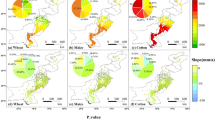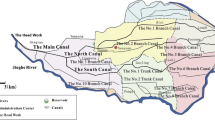Abstract
By considering numerical features, spatial variation, and spatial association, the spatial patterns of China’s irrigation water withdrawals in 2001 and 2010 were explored at the regional, provincial, and prefectural scales. In addition, an overlay analysis was used to develop specific water-saving guidance for areas under different levels of water stress and with different degrees of irrigation water withdrawals. It was found that at the regional scale, irrigation water withdrawals were highest in the Middle-Lower Yangtze River region in both years, while at the provincial scale, the largest irrigation water withdrawals occurred in Xinjiang. During 2001–2010, the total of irrigation water withdrawals decreased; however, in the Northeast region, especially in Heilongjiang Province, it experienced a dramatic increase. The spatial variation was largest at the prefectural scale, with an apparent effect. The spatial association was globally negative at the provincial scale, and Xinjiang was the only significant high-low outlier. In contrast, the association displayed a significant positive relationship at the prefectural scale, and several clusters and outliers were detected. Finally, it was found that the water stress in the northern part of China worsened and water-saving irrigation techniques urgently need to be applied in the Northeast region, the Huang-Huai-Hai Plain region, and Gansu-Xinjiang region. This study verified that a multi-scale and aspect analysis of the spatial patterns of irrigation water withdrawals were essential and provided water-saving advice for different areas.
Similar content being viewed by others
References
Anselin L, 1993. The Moran Scatterplot as an ESDA Tool to Assess Local Instability in Spatial Association. Morgantown, WV: Regional Research Institute, West Virginia University, 111–125.
Anselin L, 1995. Local indicators of spatial association—LISA. Geographical Analysis, 27(2): 93–115. doi: 10.1111/j.1538-4632.1995.tb00338.x
Blanke A, Rozelle S, Lohmar B et al., 2007. Water saving technology and saving water in China. Agricultural Water Management, 87(2): 139–150. doi:10.1016/j.agwat.2006.06.025
Frenken K, Gillet V, 2012. Irrigation Water Requirement and Water Withdrawal by Country. Rome, Italy: FAO.
Gassert F, Landis M, Luck M et al., 2014. Aqueduct Global Maps 2.1. Washington, DC: World Resources Institute. Available at http://www.wri.org/publication/aqueduct-global-maps-21.2016-7-12.
Levine N, 2004. Crime Stat III: A Spatial Statistics Program for the Analysis of Crime Incident Locations (Version 3.0). Houston (TX): Ned Levine & Associates/Washington, DC: National Institute of Justice.
Liao Yongsong, Huang Jikun, 2004. Food safety and prediction of irrigation water demand in the 21st century. China Water Resources, 1: 36–38, 5. (in Chinese)
Lovie P, 2005. Coefficient of variation. Encyclopedia of Statistics in Behavioral Science, 1: 317–318. doi: 10.1002/0470013192. bsa107
Maupin M A, Kenny J F, Hutson S S et al., 2014. Estimated use of water in the United States in 2010 (No. 1405). US Geological Survey, doi: 10.3133/cir1405
Ministry of Water Resources of the People’s Republic of China, 2011. 2010 China Water Resources Bulletin. Beijing: China Water Power Press. (in Chinese)
Moran P A, 1948. The interpretation of statistical maps. Journal of the Royal Statistical Society. Series B (Methodological), 10(2): 243–251.
Nair S, Johnson J, Wang C, 2013. Efficiency of irrigation water use: a review from the perspectives of multiple disciplines. Agronomy Journal, 105(2): 351–363. doi: 10.2134/agronj2012.0421
National Bureau of Statistics of China, 2002. China Statistical Yearbook 2002. Beijing: China Statistics Press. (in Chinese)
National Bureau of Statistics of China, 2011. China Statistical Yearbook 2011. Beijing: China Statistics Press. (in Chinese)
Nationwide Committee of Agricultural Regionalization, 1981. The Comprehensive Agricultural Regionalization of China. Beijing: Agriculture Press. (in Chinese)
Pulido-Calvo I, Roldán J, López-Luque R et al., 2003. Demand forecasting for irrigation water distribution systems. Journal of Irrigation and Drainage Engineering, 129(6): 422–431. doi: 10.1061/(ASCE)0733-9437(2003)129: 6(422)
Reig P, Shiao T, Gassert F, 2013. Aqueduct Water Risk Framework. Washington, DC: World Resources Institute. Available at http://www.wri.org/publication/aqueduct-waterrisk-framework.
Shen Zhenrong, He Weicheng, 1996. Assessment of China’s agricultural water use and approach to the solution of existing problems. Journal of Natural Resources, 11(3): 221–230. doi: 10.1016/j.agwat.2013.06.014 (In Chinese)
Shen Y, Li S, Chen Y et al., 2013. Estimation of regional irrigation water requirement and water supply risk in the arid region of Northwestern China 1989–2010. Agricultural Water Management, 128: 55–64. doi: 10.1016/j.agwat.2013.06.014
Varis O, Vakkilainen P, 2001. China’s 8 challenges to water resources management in the first quarter of the 21st Century. Geomorphology, 41(2): 93–104. doi: 10.1016/S0169-555X(01) 00107-6
Wang J, Zhang L, Huang J, 2016a. How could we realize a win–win strategy on irrigation price policy? Evaluation of a pilot reform project in Hebei Province, China. Journal of Hydrology, 539: 379–391. doi: 10.1016/j.jhydrol.2016.05.036
Wang J, Zhong L, Long Y, 2016b. Baseline Water Stress: China. Beijing: World Resources Institute. Available at: http://www.wri.org/publication/baseline-water-stress-china.2016-12-23.
Wu G, Li L, Ahmad S et al., 2013. A dynamic model for vulnerability assessment of regional water resources in arid areas: a case study of Bayingolin, China. Water Resources Management, 27(8): 3085–3101. doi: 10.1007/s11269-013-0334-z
Wu X, Zhou J, Wang H et al., 2015. Evaluation of irrigation water use efficiency using remote sensing in the middle reach of the Heihe River, in the semi-arid Northwestern China. Hydrological Processes, 29(9): 2243–2257. doi: 10.1002/hyp.10365
Zhang Zengxiang, Wang Xiao, Wang Changyao et al., 2009. National land cover mapping by remote sensing under the control of interpreted data. Journal of Geo-information Science, 11(02): 216–224. (in Chinese)
Zhang Z, Wang X, Zhao X et al., 2014. A 2010 update of National Land Use/Cover Database of China at 1:100 000 scale using medium spatial resolution satellite images. Remote Sensing of Environment, 149: 142–154. doi: 10.1016/j.rse.2014.04.004
Acknowledgements
The authors are grateful for the generous financial support of Irish Aid, the Ministry of Foreign Affairs of The Netherlands, the Ministry of Foreign Affairs of Denmark, and the Swedish International Development Cooperation Agency (SIDA).
Author information
Authors and Affiliations
Corresponding author
Additional information
Foundation item: Under the auspices of National Science and Technology Support Projects of China (No. 2014BAL01B01C)
Rights and permissions
About this article
Cite this article
Ju, H., Zhang, Z., Wen, Q. et al. Spatial patterns of irrigation water withdrawals in China and implications for water saving. Chin. Geogr. Sci. 27, 362–373 (2017). https://doi.org/10.1007/s11769-017-0871-0
Received:
Accepted:
Published:
Issue Date:
DOI: https://doi.org/10.1007/s11769-017-0871-0




